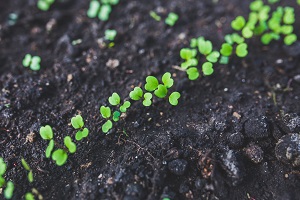May 2018
 By Scott Canning, Director of Horticulture
By Scott Canning, Director of Horticulture
May is the month that warms our gardening souls and then breaks our hearts. We seem to always have nice, warm weather in March and April that pushes our spring-blooming plants into precocious growth, and then comes our almost reliable early May hard freeze. Dang it! Why do I love my stone fruits like cherries and apricots so much? They tease me with their early bloom, and then the young fruit perishes in our frequent cruel May freezes. May can be a heart-breaking month for New Mexico gardeners, indeed.
What is a Santa Fe gardener to do? To keep myself cheered up, I focus on my seedlings. Some should be well on their way to the garden—-even tender plants can be planted out by the end of the month—-but harden them off before moving them outside! “Hardening” is the process of preparing your tender, fragile seedlings to a life outdoors—-where harsh forces lurk, ready to toast, freeze, or wind-blow your little babies. Introduce them to the great outdoors slowly: Wait for a calm, warm day and in the morning place them outdoors in a somewhat shady, sheltered position for a time (because seedlings can sunburn, or get flattened!), then put them back in their “nursery”. Increase the seedling’s exposure to these harsher, real-world conditions as gradually as you can; this is “hardening off”. Remember that a few well-loved plants, like basil and coleus, do not like so much as a CHILL, never mind a frost. So be patient with them. And the same advice goes for tomatoes, chilies and melons: If you plant them out too soon, you will have nothing to gain; they will just sulk— or die!
 Keep up with weeding and mulching, and be sure you have your roses pruned ASAP if you haven’t done that yet: It is not too late, and for established roses, it is better to prune too late than not to prune at all. Then feed them: roses are heavy feeders (see below).
Keep up with weeding and mulching, and be sure you have your roses pruned ASAP if you haven’t done that yet: It is not too late, and for established roses, it is better to prune too late than not to prune at all. Then feed them: roses are heavy feeders (see below).
Organic fertilizers are great to add to the garden in May. Compost is “black gold” and you can never go wrong adding it to your garden and soil, but the more expensive organic fertilizers are best timed a bit more carefully: Don’t let them wash away or blow away in the winter when all is harsh and dormant: May is a great time to use them, just as plants begin vigorous root growth, and soil organism activity is ramping up. Remember that organic fertilizers feed not just your plants but more importantly your soil, and your soil is the matrix that supports all of the life in your garden.
Now is also a great time to fill containers and bare spots in your garden with “hardy annuals”, the spring jewels that can tolerate frost and add immense joy to the season. Think pansies, johnny-jump-ups, calendulas, California and Iceland poppies, to name just a few. If “hardened” before being placed in gardens or pots, they laugh at the cold, and provide joy until the heat of June sets in: Then all kinds of tender plants replace them for the long growing season.


